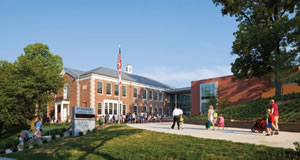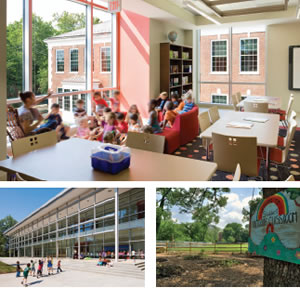The Learning Landscape
How rich outdoor opportunities foster 21st-century education.
- By Sean O'Donnell
- 11/01/13

PHOTOS © JOSEPH ROMEO
The marks of a 21st-century education — creativity, critical thinking, communication and character — and the means to acquire these skills — more active, student-centered and collaborative learning — and the flattening of the world have changed our expectations for the learning environment. We know now that learning occurs not only in the traditional, formal settings of a school, but also that much is learned outside of the classroom, in informal settings and from one’s peers.
Today, we design the entire campus — not just classrooms and labs — as a system of settings in which to learn, recasting circulation as “extended learning spaces,” media centers and cafeterias as “learning commons” and the outdoors as a landscape of comprehensive opportunity — where the humanities, sciences and physical activity intermingle and converge with social and emotional learning to help educate the whole person.
Schools today are diverse learning landscapes, a series of indoor and outdoor places that afford a wide range of educational activities that comprise a 21st-century education. In this article, we focus on the outdoors — on places that encourage students to build community, perform, collaborate, cultivate, create, play and socialize.
Build community
Our educational environments strive to support the creation of a cohesive learning community. In doing so, a key opportunity occurs at the margins of the school day, at the arrival and the departure to and from the campus, when the school community can gather informally and socialize. Accordingly, a designated place at a building’s or campus’ entrance that allows for the planned and serendipitous encounters of this daily ritual can bind the community together. As many of our civic buildings and monuments have shown, broad, gentle steps approaching a building entrance often become seating, and in more formal moments, a place to address an audience.
Perform
Inspired by the origins of theater rooted in open-air performance, contemporary learning landscapes can take advantage of steps or amphitheaters to create settings for class discussions and recitations, musical performances and commencement ceremonies. Amphitheaters also often perform well as a space for small groups and individuals to socialize and reflect. Typically nestled into a site’s topography, an amphitheater can also help ensure participation by all — for example, by using its arc to create an accessible route from an upper elevation to the stage.
Collaborate
The outdoors can readily support students working in small groups on diverse projects. Simple round tables with benches provide for opportunities to engage in the setting as a multi-centered, project-based classroom with no front (with campus-wide wireless access, technology is readily accessed.) If conveniently situated, the tables will almost certainly fill up for lunch on a pleasant day and, if in a public location near an entrance or playground, families may fill the seats on weekends as children play.
Cultivate
Gardens have long been popular with early childhood programs but with the growing interest in health and wellness and locally produced food, they are being increasingly integrated into the curriculum for all ages. Successful gardens — from expansive plots and greenhouses to small green roofs and rooftop hydroponic gardens — engage students in a wide range of curricula while providing activities suitable for focused work or discussion groups.
Create
Like the performing arts, the visual arts have a long tradition of working in the open air. Like an art studio, outdoor artistic endeavors may be best served by spaces that are simple in design, well ventilated and created with robust, often industrial materials that can survive the creative process. Convenient, unobtrusive access for supply delivery and storage and adjacency to indoor arts spaces often complements these places.
Play
Play can be fostered in almost any place that provides a rich set of kinesthetic, social and creative opportunities. Childrens’ rich imaginations will make the most of the opportunities provided. Accordingly, perhaps the most successful settings provide a range of opportunities for discovery and experiences that inspire and challenge children as they grow and develop.

Socialize
Like play, socialization can occur in many places, but it occurs best in places that allow for a small group to gather, oftentimes within a comfortable subset of a larger public place. In this way the group can define itself but also concurrently participate in the larger community. For example, a bench and a low wall at an entrance allows for a group of students to talk while also engaging peers arriving and leaving the building. The ability to foster planned groupings and serendipitous encounters through loose and fixed features will often determine the success of a larger public place. The most successful places also engage multiple levels, through stairs, overlooks and terraces.
Boundaries and thresholds
The activities described above often occur best in well-defined places — a courtyard, canopy, platform, amphitheater or rooftop. As with interior space, boundaries and edges and the resources they contain provide cues to the proper use of a place and often the acoustical separation to make their use successful. Equally important, however, are the thresholds that signal arrival and allow for visual and physical connectivity between places. As the boundaries blur between classrooms and extended learning spaces, visual connectivity between outdoor places and between indoor and outdoor places can enrich the experience of both, foster engagement of adults and students, and contribute to the success of the activity — science labs can open onto a green roof, stages to amphitheaters, dining areas onto a garden.
Micro-climates and site constraints
The success of an outdoor place will depend upon the comfort of the users. Orientation and the creation of micro-climates using adjacent buildings and the landscape to control the elements can foster the use of many outdoor spaces in many locations throughout much of the year. For example, even on the most dense urban sites, south-facing roof terraces can be bathed in sun throughout the year.
Even the smallest sites can provide a meaningful and productive connection to the outdoors. When creating a robust learning landscape, rich with opportunities for the diversity of activities outlined above, every square foot should count.
This article originally appeared in the School Planning & Management November 2013 issue of Spaces4Learning.
About the Author
Sean O'Donnell AIA, LEED-AP, is a principal and practice area leader of primary and secondary education with Perkins Eastman in New York.